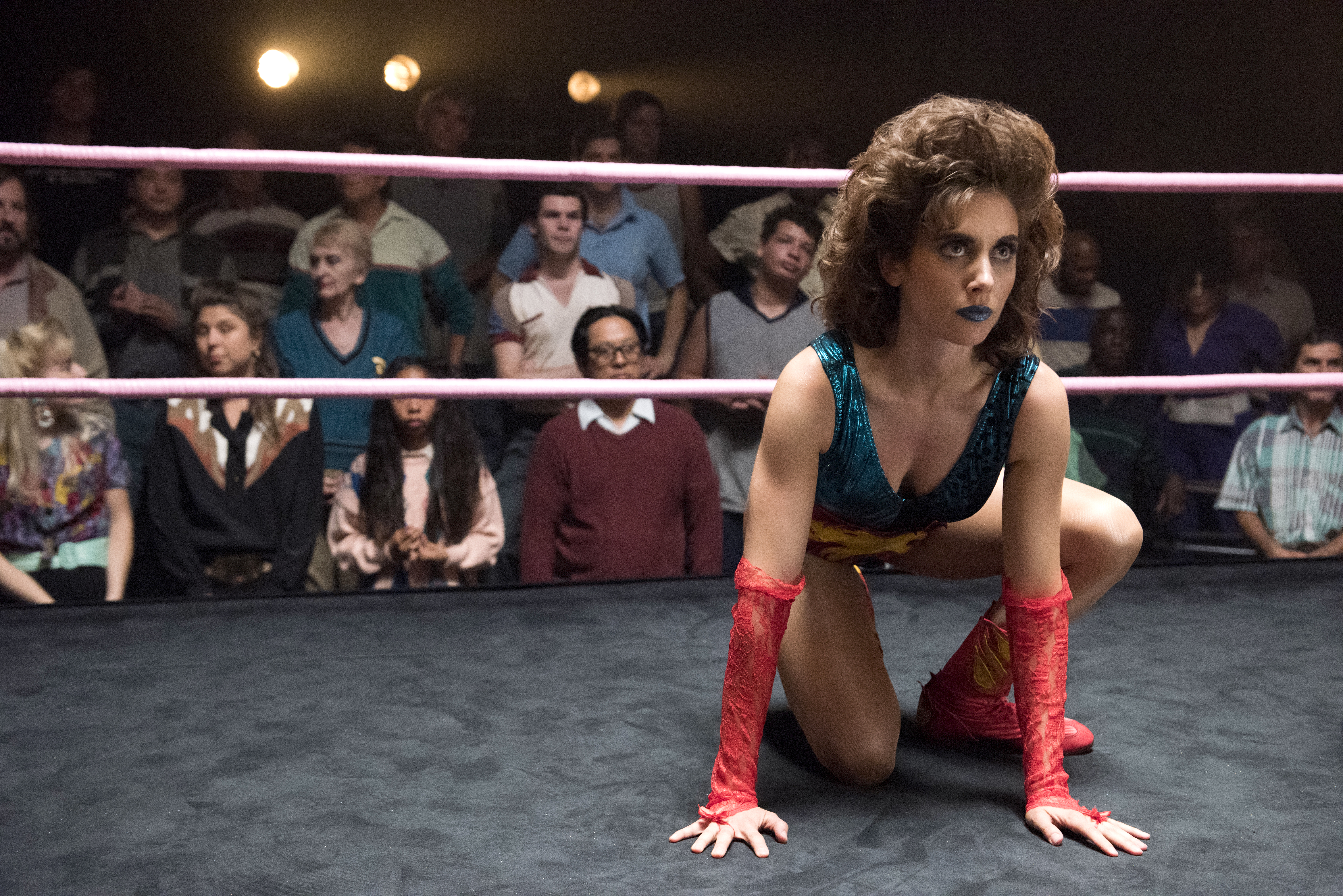Don’t judge “GLOW” by its first episode. Or even the next two. The Netflix original series about the real-life “Gorgeous Ladies of Wrestling” league spends its first three half-hours largely focused on its lead character, Ruth (Alison Brie). Though created by Liz Flahive and Carly Mensch, “GLOW” is executive produced by Jenji Kohan and Tara Hermann. And like Taylor Schilling‘s Piper in Kohan’s “Orange Is the New Black,” Brie’s Ruth is one of the show’s least interesting characters. Once the series expands its focus beyond her to its fascinating, diverse cast in the fourth episode, the comedy is infused with a new energy.
Set in 1985 Los Angeles, “GLOW” begins with down-on-her-luck actress Ruth auditioning without success, financially supported by her parents and emotionally supported by her best friend, Debbie (Betty Gilpin). With few options, Ruth accidentally attends a try-out for “Gorgeous Ladies of Wrestling” and wins a part in the show. Helmed by bitter B-movie filmmaker Sam Sylvia (Marc Maron) and bankrolled by rich kid Bash Howard (Chris Lowell), the league is supposed to be the low-budget, female answer to the WWF.

The group is a motley crew of actresses, athletes and amateurs with almost no experience in the entertainment they’re about to perform. Cherry Bang (Sydelle Noel) is a married stuntwoman who previously worked with Sam, while Melrose (Jackie Tohn) is a party girl and music video babe. Carmen (Britney Young) is the only woman in a family of wrestlers, and Reggie (Marianna Palka) is an ex-pro athlete. Then there’s Sheila the She Wolf (Gayle Rankin), a young woman who spends every moment dressed as, well, a wolf. As the season progresses, each female wrestler finds her wrestling identity and develops it in and out of the ring, but Ruth struggles to find her character as she struggles with her personal life as well.
Meanwhile, “GLOW” finds its own footing from the first moments in episode four, “The Dusty Spur,” which moves all the ladies into a run-down motel together. Opening with “Life in a Northern Town” by The Dream Academy, the show gives us insight into Sheila the She Wolf’s character and it feels like an entirely different – and better – series from those early seconds. The next episode, “Debbie Does Something,” gives Debbie (and Gilpin) a chance to shine, ending with a triumphant use of Scorpions‘ “Rock You Like a Hurricane.” The musical cues in “GLOW” are solid, taking full advantage of its ’80s setting. Punk-rock wrestler Janine (Britt Baron) commits a bold act set to “Ready Steady Go” by Generation X in “This Is One of Those Moments,” and a training montage in “Live Studio Audience” is edited to “Dare” by Stan Bush from “Transformers: The Movie.”

“GLOW” is a product of its female talent behind the camera. Beyond the influence of showrunners Flahive and Mensch, episodes are directed by Lynn Shelton, Melanie Mayron, Kate Dennis, Sian Heder, Claire Scanlon, and Wendey Stanzler. There’s a definite female gaze here, while a straight male filmmaker might have focused more on the flesh exposed by the workout wear and wrestling costumes. One motel room scene in “The Dusty Spur” refuses to focus on the bare breasts of a character, and instead centers on her new roommate’s reaction to them. The feminist approach starts with the scripts: Kohan, Flahive, and Mensch are joined as credited writers by Sascha Rothchild and Rachel Shukert. The relationships between the women are nuanced, and the show dwells on the various female and racial stereotypes that its characters have to deal with. Like “Orange Is the New Black” at its best, “GLOW” succeeds when it showcases perspectives of women that aren’t normally given time in other shows.
The fault in the first episodes is more on the writers’ shoulders than with Brie’s performance. As written, she’s overeager, as though the public perception of Anne Hathaway were transported whole cloth into this show. It’s a lot to deal with, largely because Brie is so good. As we’ve seen her elsewhere in “Community” and “Mad Men,” she’s committed to the character she plays, who begins the show desperate and dorky and has thankfully evolved by the final episodes of the first season. The more “GLOW” focuses on its tertiary characters – particularly Young’s wonderfully warm Carmen and Noel’s strong leader Cherry (and her sweet relationship with her husband, played by Bashir Salahuddin) – the better it is. The casting of the show is perfect, from Brie as the lead to the downbeat note that Maron brings to his past-his-prime filmmaker.

If “GLOW” were a network show, its slow start might have hindered it in the long run. However, the Netflix binge model – and the easy digestibility of the series’ half-hour format – means that audiences will likely keep watching after its imperfect beginning. They’ll be rewarded by a funny, insightful comedy filled with a variety of characters who all get their chance to shine. [B+]





